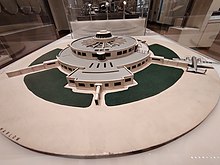Gibraltar has a limited public transport system, due to the compact size of the territory.

London Heathrow Airport colloquially known as Heathrow and named London Airport until 1966, is the primary and largest international airport serving London, the capital and most populous city of England and the United Kingdom. It is the largest of the six international airports in the London airport system.

Stansted Airport is an international airport serving London, the capital of England and the United Kingdom. It is located near Stansted Mountfitchet, Uttlesford, Essex, 42 mi (68 km) northeast of Central London.
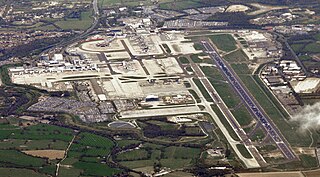
London Gatwick, also known as Gatwick Airport, is the secondary international airport serving London, England. It is located near Crawley, West Sussex, England 29.5 miles (47.5 km) south of Central London. In 2022, Gatwick was the second-busiest airport by total passenger traffic in the UK, after Heathrow Airport, and was the 8th-busiest in Europe by total passenger traffic. It covers a total area of 674 hectares.
EasyJet plc is a British multinational low-cost airline group headquartered at London Luton Airport. It operates domestic and international scheduled services on 927 routes in more than 34 countries via its affiliate airlines EasyJet UK, EasyJet Switzerland, and EasyJet Europe. The company employs circa 13,000 people, based throughout Europe but mainly in the UK. EasyJet plc is listed on the London Stock Exchange and is a constituent of the FTSE 100 Index.

London Luton Airport is an international airport located in Luton, Bedfordshire, England, situated 1.7 miles (2.7 km) east of the town centre, and is the fourth-busiest airport serving London. The airport is owned by Luton Rising, a company wholly owned by Luton Borough Council, and operated by London Luton Airport Operations Ltd (LLAOL).

London City Airport is a city airport in London, the capital of England and the United Kingdom. It is located in the Royal Docks in the Borough of Newham, about 6 miles (9.7 km) east of the City of London and 3 miles (4.8 km) east of Canary Wharf. These are the two centres of London's financial industry, which is a major user of the airport. The airport was developed by the engineering company Mowlem between 1986 and 1987. In 2016 it was bought by a Canadian-led consortium of AIMCo, OMERS, the Ontario Teachers' Pension Plan and Wren House Infrastructure Management of the Kuwait Investment Authority.

Manchester Airport is an international airport in Ringway, Manchester, England, 7 miles (11 km) south-west of Manchester city centre. In 2022, it was the third busiest airport in the United Kingdom in terms of passengers and the 19th-busiest airport in Europe in 2023, with 28.1 million passengers served.

Belfast International Airport is an international airport 11.5 NM northwest of Belfast in Northern Ireland, and is the main airport for the city of Belfast. Until 1983, it was known as Aldergrove Airport, after the nearby village of Aldergrove, County Antrim. In 2023, over 5.9 million passengers travelled through the airport, a 23.6% increase compared with 2022. The majority of flights from Belfast International are operated by easyJet, Northern Ireland's biggest airline. It features flights to some European metropolitan and several leisure destinations.
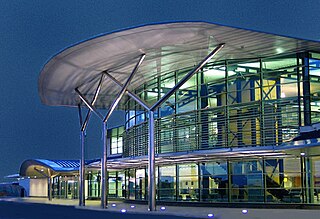
Guernsey Airport is an international airport on the island of Guernsey and the largest airport in the Bailiwick of Guernsey. It is located in the Forest, a parish in Guernsey, 2.5 nautical miles southwest of St. Peter Port and features mostly flights to Great Britain and some other European destinations.

GB Airways was a British airline; prior to its sale, it was headquartered in 'The Beehive', a former terminal building, at City Place Gatwick, London Gatwick Airport in Crawley, West Sussex, England.

Gibraltar International Airport, previously known as North Front Airport, is the civilian airport that serves the British overseas territory of Gibraltar. The runway and aerodrome is owned by the Ministry of Defence (MoD), and operated by the Royal Air Force (RAF) as RAF Gibraltar. Civilian operators use the civilian-operated terminal. National Air Traffic Services (NATS) hold the contract for provision of air navigation services at the airport.

Dalaman Airport is an international airport and one of three serving southwest Turkey, the others being Milas–Bodrum Airport and Antalya Airport. It has two terminals. The old terminal is used for domestic flights and the new terminal is for international flights. The airport serves the surrounding tourist areas of Ölüdeniz, Dalyan, Fethiye, Hisarönü, Ovacık, Kaş, Kalkan and environs of Dalaman. Flights are available to and from over 120 destinations, across the rest of Turkey, Europe, North Africa and the Middle East.
The Bland Group Ltd. is made up of a number of small and medium-sized operating companies based in Gibraltar, the United Kingdom and Morocco.

Lowfield Heath is a former village within the boundaries of the Borough of Crawley, West Sussex, England. Situated on the main London to Brighton road approximately 27 miles (43 km) south of London and 2 miles (3.2 km) north of Crawley, it was gradually rendered uninhabitable by the expansion of London Gatwick Airport immediately to the north.

Tinsley Green is an area in the Borough of Crawley, one of seven local government districts in the English county of West Sussex. Originally a hamlet in the parish of Worth, it was absorbed by the New Town of Crawley in the 1940s and became part of the Pound Hill neighbourhood. As well as houses, farms and woodland, it became the site of the 1930s aerodrome at Gatwick—now London Gatwick Airport. The airport's first railway station was briefly known as Tinsley Green. The game of marbles has a strong local tradition, and Tinsley Green's pub hosts the British and World Marbles Championship each year.
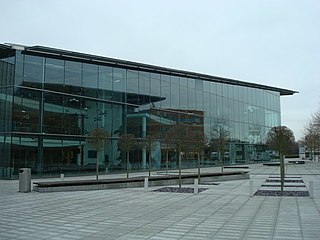
City Place Gatwick is an office complex located on the property of London Gatwick Airport in Crawley, West Sussex, England. The complex includes four buildings: The Beehive, an approximately 20,000-square-foot (1,900 m2) former terminal building at Gatwick Airport located on a 2.0-acre (0.81 ha) site; 1 City Place a 131,500-square-foot (12,220 m2) facility on a 4.2-acre (1.7 ha) site, 2 City Place, a 85,000-square-foot (7,900 m2) building on a 1.9 acres (0.77 ha) plot, and 3 City Place, a 65,000-square-foot (6,000 m2) building on a 1.06-acre (0.43 ha) plot. Hamiltons Architects designed the L-shaped 3 City Place.
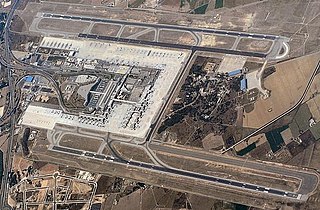
Palma de Mallorca Airport — also known as Son Sant Joan Airport – is an international airport located 8 km (5.0 mi) east of Palma, Mallorca, Spain, adjacent to the village of Can Pastilla.
In its early years what is now Heathrow Airport was the Great West Aerodrome, sometimes known as Heathrow Aerodrome.
Gatwick Airport was in Surrey until 1974, when it became part of West Sussex as a result of a county boundary change. The original, pre-World War II airport was built on the site of a manor in the parish of Charlwood. The land was first used as an aerodrome in the 1920s, and in 1933 commercial flights there were approved by the Air Ministry.


